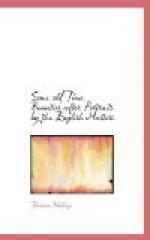Walpole says she was never mentioned by her contemporaries but as the most perfect creature they had ever known. The present Duke wedded that charming child, Lady Elizabeth Leveson Gower, who sits on her mother’s knee in that surpassingly fine picture by Lawrence, called “Lady Gower and Child.” And his son is allied to the Princess Louise, the most comely of Victoria’s daughters.
After her sister’s death, in 1760, her Grace of Argyll suffered a decline in health. She was ordered abroad for change. She was appointed to accompany the Princess Sophia Charlotte on her journey to England to be married to the King. As they neared the ceremony in London, the Princess became nervous. Her Grace essayed to quiet her fears. “Ah, my dear Duchess, you may laugh at me, but you have been married twice,” said the Princess. The Duchess became one of the ladies of the bedchamber, and was in much favor with the Queen.
In 1767, her father died at Somerset House, and her mother, the Hon. Mrs. Gunning, in 1770. There were three sisters in the family besides our heroines: Sophia Gunning died, an infant, in 1737; Lissy, who died in 1752, aged eight years; and Catherine, who was married, in 1769, to Robert Travis an Irish squire in her own rank of life. She died, too, at Somerset House, in 1773, where she was an upper housekeeper. A brother entered the army, fought at Bunker Hill, and became a major-general in 1787. He was much of a ladies’ man. He married a Miss Minfie, author of some novels, and they had a daughter who aspired to repeat the successes of her famous aunts. She managed to marry the Hon. Stephen Digby, who had lost his first wife, a daughter of Lord Ilchester, in 1787. The Duchess of Argyll was created, in 1776, a peeress of England as Baroness Hamilton of Hambledon County, Leicester, and died in December, 1790. By her second marriage she had two sons, successively Dukes of Argyll, and two daughters, one of whom, Lady Charlotte Campbell, attained some fame as a novelist as Lady Charlotte Bury, she having married Colonel John Campbell and secondly Rev. Edward Bury.
We have no evidence of the possession of bright Irish wit by the double-duchessed beauty. Ingenuous enthusiasm, perfect simplicity, and unfailing good humor ever marked her manner, and were a captivating adjunct to her great facial charm. Walpole writes of a pretty sight when their Graces of Hamilton and of Richmond with Lady Ailesbury sitting in a boat together, and proceeds to tell of the suspected jealousy by she of Hamilton of the beauty of his niece, daughter of Sir Edward Walpole, who became the bride of Earl Waldegrave, and later married the Duke of Gloucester, the King’s youngest brother. At another time, when a lady wrote telling him of the advent of a beauty who was expected to outvie the Gunnings, he replies: “There was to have been a handsomer every summer these seven years, but when the seasons come they all seem to have been addled by the winter.”




